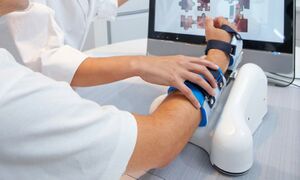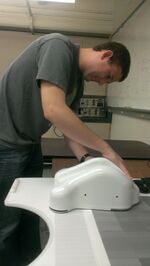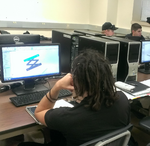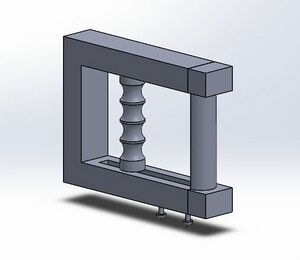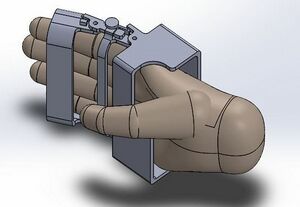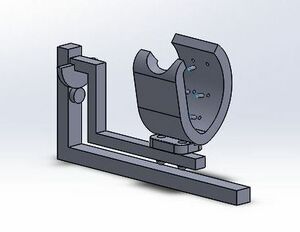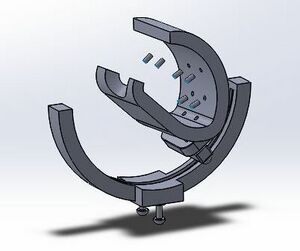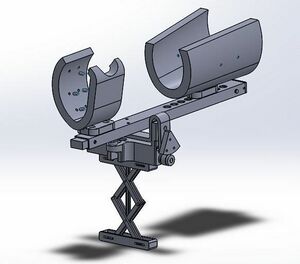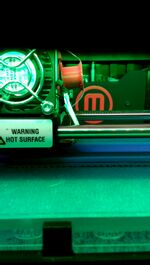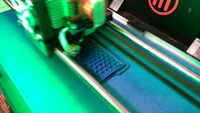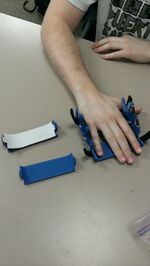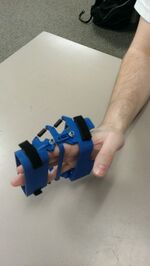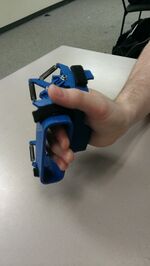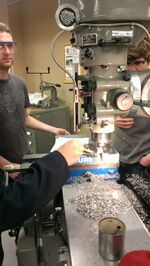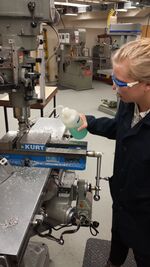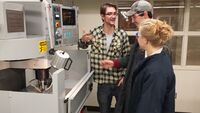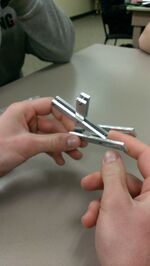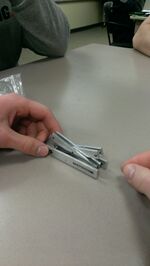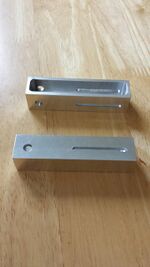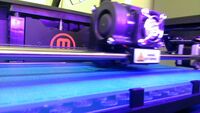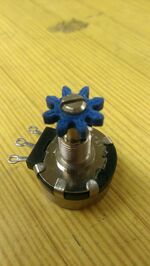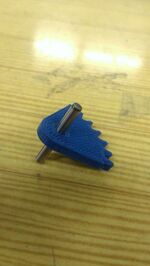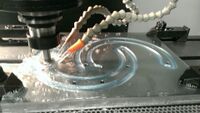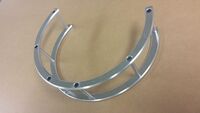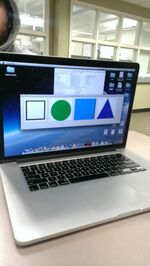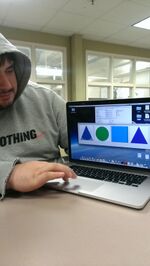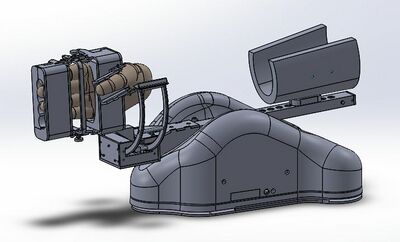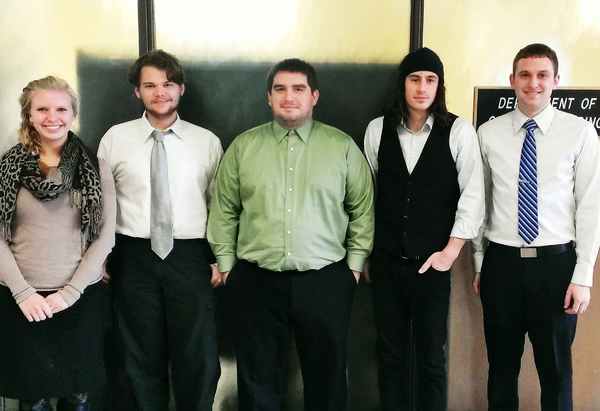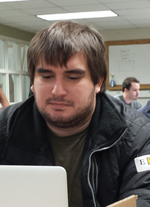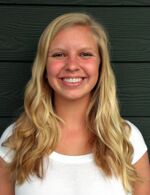Robotic Arm Assist
| 2013 University of Idaho Capstone Senior Project | |
|---|---|
| Tecnalia's prototype robot [1] | |
| Sponsors | |
| Team Name | Arm Assist |
| Duration | Fall 2013 - Spring 2014 |
| Tecnalia Representative | Joel Perry |
| Faculty Advisor | Dr. Matthew Riley |
| Mentor | Jon Teske |
| Team Members | Joe Osborn, Roman Pacheco, Brenden Staab, Kadrie Swanson, Steven Witkoe |
| Questions or Comments? | email Kadrie Swanson at swan5849@vandals.uidaho.edu |
Extending an Arm Toward the Future
Assisting Tecnalia's venture in designing a rehabilitation robot to aid stroke victims in their recovery. Our mission is to design and build a set of add-on modules to extend the functionality of an existing arm rehabilitation robot for Tecnalia.
Development and Project Goals
TECNALIA's Arm Assist Robot is an assistive robot for the rehabilitation of patients with upper limb neuromuscular impairment, specifically for patients who have suffered from a stroke. This assistive robot is accompanied by a tele-rehabilitation platform, thus allowing rehabilitation at home under supervision from the therapist by its quantitative evaluation.
ARMASSIST represents a major technological breakthrough which allows TECNALIA to address the growing market demand for personalized care. This initiative was born to meet the needs of the 15 million people who suffer brain-vascular damage every year; of that figure 5 million suffer permanent disability.[[2]]
The Robotic Arm Assist team, provided by the University of Idaho, will work through the capstone project to further develop the rehabilitation robot. The team will add to the overall functionality of the robot by providing TECNALIA with modules that will increase the current lift function, ability to rotate wrist, and ability to open and close the patient's hand.
Design Goals
Our design goals for the project are to build a grip, twist and lift modules to incorporate with current design with few alterations. Our modules should be passive and able to stand alone, with the capabilities of being powered and used in conjunction with one another depending on the needs of the user.
Design Specifications
Grip Module
- Sense full grip 1-2° (individual fingers not necessary)
- Incorporate vibration feedback when full grip is complete
- Help individuals complete tasks when necessary
Wrist Rotation Module
- Allow rotation of ±90°ideally (minimum ±60°)
- Help individuals complete tasks when necessary
Arm Elevation Module - Lift Module
- Allow 4” of arm lift without lifting the device (2” minimum)
Other Modify GUI to show output from modules and display them in a useful manner for the future development of games.
Project Learning
Throughout the project learning section of our design process we were able to conclude several general ideas in order to start progress in the correct direction. Primarily, we have gained a greater understanding as to what is occurring in a stroke victim’s body from the lesion in the brain to the synergies that react when the person attempts to send a call from the brain to the body. The severity is rated on a Rankin Scale (RS). This understanding will help us design the modules specifically to help the victims in the RS that we are directed towards.
- Learn more: Muscle coordination and synergies [[5]]
We have also gained much understanding in the hardware in use. Being able to look at the robot and visualize the scale of module we need to produce was helpful in comprehending the module’s needs. Research pricing and variability of strengths in hardware was helpful in producing a very rough budget. After researching the PCB hardware necessary to handle each of these modules, we were able to understand it's limits. Specifically, the research into components that measure distance and force was invaluable to our preliminary research and understanding how to design a functioning module that will meet the specifications provided for us.
- Learn more: Initial pricing research, aluminum [[8]]
- Learn more: Initial research on PCB
Finally, researching the ideas and current prototypes of the same general concepts on the internet was very important in understanding what the biggest challenges will be for us (i.e. making the design simple enough to actually use). This was very helpful in attempting to see flaws in other designs and well as general concepts that could be incorporated into our design, while being aware of patent-ability.
- Learn more: Potentiometer [[9]]
- Learn more: Load Cell [[10]]
In conclusion, we believe the amount of knowledge that we spent in the project learning section of our process will be very valuable in our conceptual design process along with throughout the entire design.
Preliminary Research
Morphology Chart Summary
Each member of the team was asked to sketch 3 to 5 design concepts to analyze. The designs were evaluated by general feasibility in a series of meetings. The ideas that were found infeasible were reconsidered and combined with other ideas to be made feasible again, in order to have a wide variety of viable options to consider.
Designs were then evaluated on capability, ranging from 1 to 5, the highest score being the most capable. Each specification was given a value (found immediately before the description) that represents its weight in reference to the other specifications; higher values are directly correlated to its importance. These numbers were then put into a morphology chart; the designs with the highest weighted totals were then further scrutinized to ensure that we were choosing the most advantageous designs.
The designs were then analyzed upon the following specs (1 being incapable 3 being moderately capable and 5 being very capable):
Grip Design's Specifications and Values
- Help Open – (1) does this module assist in opening the hand
- Help Close – (1) does this module assist in closing the hand
- Accuracy – (1) would this module be able to accurately measure its task
- Adjustable – (1.25) would this module be adjustable to all sizes
- Easy to put on – (1.5) would this module be easy for the user to put on
- Passive – (1) would this module be able to be made passive
- Active – (.25) would this module be able to assist in making these movements for the user
- Simplicity – (.25) how complex is this module
- Machinability – (.6) how easy would this module be to machine in shop
- Cost – (3) overall cost of this module (five being most cost efficient)
- Integration – (.75) how easy would this module be to integrate into the current prototype
- Longevity – (.9) will this module be a long lasting device
- Safety – (2) will this module be safe for the average at home user
Lift Design's Specifications and Values
- 2” – (1) would this module have a range of 2”
- 4” – (1)would this module have a range of 4”
- Accuracy – (1) would this module be able to accurately measure its task
- Force required – (1.25) how much force would be necessary for the user to apply
- Weight – (1.25) weight of module in device
- Simplicity – (.6) how complex is this module
- Machinability – (.9) how easy would this module be to machine in shop
- Cost – (3) overall cost of this module (five being most cost efficient)
- Integration – (1.5) how easy would this module be to integrate into the current prototype
- Longevity – (.75) will this module be a long lasting device
- Safety – (2) will this module be safe for the average at home user
Wrist Rotation's Specifications and Values
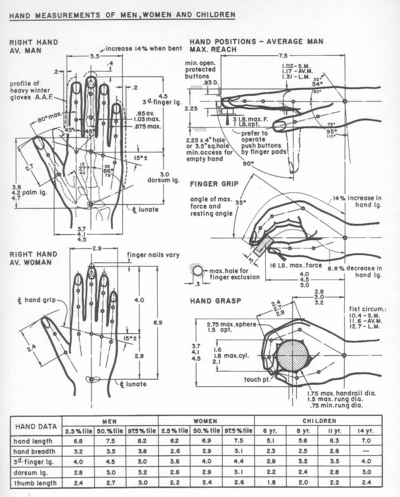
- ±90° – (.6) would this module have a range of 90°
- ±60° – (1) would this module have a range of 60°
- Accuracy – (1.1) would this module be able to accurately measure its task
- Easy to put on – (1.5) would this module be easy for the user to put on
- Passive – (1) would this module be able to be made passive
- Active – (.4) would this module be able to assist in making these movements for the user
- Simplicity – (.75) how complex is this module
- Machinability – (.75) how easy would this module be to machine in shop
- Cost – (3) overall cost of this module (five being most cost efficient)
- Integration – (1.25) how easy would this module be to integrate into the current prototype
- Longevity – (.9) will this module be a long lasting device
- Safety – (2) will this module be safe for the average at home user
Completed Morphology Chart found here [[11]]
Anthropometric Research
In order to have an ergonomically sound device, each portion of the device needs to be built in reference to the human body. Therefore, the 1st, 5th, 10th, 50th, 90th, 95th, and 99th percentile measurements of the length of the forearm, hand, and fingers along with the breadth of the four fingers, and the hand were taken of both male and females, with the intention of designing the modules to be able to fit 5th through the 95th percentiles.
Anthropometric data found here [[12]]
Concept Development
Following the preliminary research, the top rated modules from the morphology chart were chosen. These modules were then drawn in Solidworks and were analyzed, searching for errors and miscalculations.
Grip Concept Development
This simple Linear Grip Concept Design on the left allows the hand to be completely opened and resists being closed, which combats the gripping synergies, but does not allow for a natural grasp. The more complex Multi-grip Concept Design on the right simulates a more natural grasp which allows to assistance in opening and closing of the hand, that would combat gripping synergies as well.
Wrist Rotation Concept Development
The wrist rotation concept design on the left has a center rotation pivot, giving the user a centralized rotation. This is intended to simulate a natural movement. The wrist rotation concept design on the right is a half ring design, this rotation is a fully stabilized rotation. Stabilization along with the natural movement associated with the half ring would be beneficial for the user.
Lift Concept Development
The Scissor Concept Design on the left is a very simplistic lift mechanism that takes up a relatively small space and completes the action in both passive and active forms. The Linear Lift Concept Design is a lift mechanism that can be both passive and active but needs alteration of the original robot.
Concept Analysis
In order to analyze each design, and have a full understanding of how each design functions, the prototypes are manufactured and assembled. Steven Witkoe and Kadrie Swanson have taken leading roles in the machining and 3D printing processes. A big thank you goes out to our mentors; Russ Porter, Jonathan Teske, and undergraduate student mentors.
Grip Prototype Analysis
The grip module has been built using a 3D printer and 3D printing filament. Seven separate pieces were uploaded onto the printer, printed and assembled with screws, hook and loop fabric, and foam.
Analysis of this prototype:
This design successfully completes all of the specifications from our client. Modifications will be made to individual pieces to make it more comfortable to the user.
|
3D printing |
||||
| 3D printing | Honeycomb interior | |||
| Grip analysis | ||||
| Open Shell | Full hand extension | Closed grip | semi-closed grip |
Scissor Prototype Analysis
The prototype scissor modules have been built using 1/8th inch aluminum plate for the folding support links, pins, and ball bearings for smooth movements. The top and bottom platforms for bracing the links and holding the potentiometer will be built out of aluminum as well.
Analysis of this prototype:
This design successfully completes all of the specifications from our client. Modifications will be made to the base system and the edges of the links will be curved, but the over all design will remain the same.
The scissor module will be sensed with a potentiometer near the base pin, in order to get a reading of this pin we will attache gears to rotate and sense the amount of rotation.
|
Machine Shop |
||||
| Steven writing MasterCam code | Steven working on the vertical milling machine | Kadrie working on the vertical milling machine | Shop mentors, Jon Teske and Matt Kologi, and Kadrie on the CNC machine | |
| Scissor analysis | ||||
| 1st prototype links | Links in 1st prototype bracket | 1st prototype bracket | 1st completed scissor prototype | |
| Gear prototyping | ||||
| 3D printing gears | 3D printed gears for scissor lift | Gear on the potentiometer | Pinion gear on the pin that will be press fit in the bearing of the scissor lift |
Wrist Rotation Prototype Analysis
The wrist rotation first prototype has been built out of 1/4" steel plates and 1/4" cylindrical extruded and 1/4" square aluminum.
The ring design was designed in Solidworks, coded in MasterCAM and then cut using the CNC machine. The dual rings will glide on a V shaped bearing allowing rotation. This rotation will be sensed using a gyroscope in the box that will hold the gliding rings. We need to continue the machining process and have a full assembly to gather a full analysis on this module.
|
Ring Design |
|||
| CNC machine cutting out the rings | Rings put together using the machined brackets | Rings put together using the machined brackets |
Computer Interface Prototype Analysis
The computer-module interface has been built using java script. Progress continues.
|
Computer Interface analysis |
||
| 1st computer interface prototype | Roman working with computer interface |
Final Product
Throughout the semester, through a variety of prototypes, we have adjusted many of our original ideas to better fit the desires of our client. This process has not only taught us how to quickly and accurately make new adjustments but also to foresee problems more effectively.
|
Our current combined prototype, as seen on the left, is the latest gripping module sitting inside the wrist rotation module which are attached to the stabilization bar that sits above the enclosed arm elevation unit. This prototype is indicative of the final product. |
Consultants
Dr. Joel Perry
Project Manager - TECNALIA, Rehabilitaiton Technologies Dept., Health Division
Adjunct Faculty - University of Idaho, Mechanical Engineering
Dr. Matthew Riley
Assistant Professor
http://www.uidaho.edu/engr/me/faculty/matthewriley
Chris Ohlinger
Fall Semester Graduate Student Mentor
Jon Teske
Spring Semester Graduate Student Mentor
Team Members
| Arm Assist Team: Kadrie, Brenden, Roman, Joe, and Steven |
|---|
| Joe Osborn | Hobbies and Interests: My professional interests have always been geared towards helping people and making a difference, and thus I have been interested in the bio-med and bioengineering fields. In my free time I enjoy several board sports, including snowboarding, wake surfing and longboarding. Along with this I am an avid rock climber.
| |
| Mechanical Engineering Student | ||
| Hometown: Gig Harbor, WA | ||
| Email: osbo8726@vandals.uidaho.edu | ||
| Roman Pacheco | Hobbies and Interests: Building and programing computer systems. Designing applications for implementation on microcontrollers and FPGA's. Also spend time cooking, playing baseball and target shooting.
| |
| Computer Engineering Student | ||
| Hometown: Arco, Id | ||
| Email: pach7646@vandals.uidaho.edu | ||
| Brenden Staab | Hobbies and Interests: I enjoy skiing, reading, playing video games, and writing.
| |
| Biological Systems Engineering Student | ||
| Hometown: Worland, Wyoming | ||
| Email: staa1939@vandals.uidaho.edu | ||
| Kadrie Swanson | Hobbies and Interests: My professional interests center around the application of ergonomics in engineering, I apply this at my current internship working on the Advanced Accessible Pedestrian System. At the University of Idaho, I am a member of the Concrete Canoe Club in addition to being the president of the Agricultural and Biological Engineering Club and the secretary/fundraising chair to the Civil Engineering Club. In my spare time, I enjoy reading, cooking, and playing tennis.
| |
| Biological Systems Engineering Student | ||
| Hometown: Fargo, North Dakota | ||
| Email: swan5849@vandals.uidaho.edu | ||
| Steven Witkoe | Hobbies and Interests: My academic interests include robotics and fluid dynamics. I have taken multiple classes that relate to these topics including Robotic Kinematics, Control Systems, and Computational Fluid Dynamics. I also enjoy running, cooking and watching my hometown basketball team, the Gonzaga Bulldogs.
| |
| Mechanical Engineering Student | ||
| Hometown: Spokane, WA | ||
| Email: witk8835@vandals.uidaho.edu |
Meetings
|
Team meetings: |
Mondays at 2:30, Design Suite |
| Team meetings with Mentor: | Wednesdays at 2:30, Design Suite |
| Sponsor meetings: | As necessary, BEL 111 |
Frequently updated agendas [[13]] and minutes [[14]]available on dropbox.
Schedule
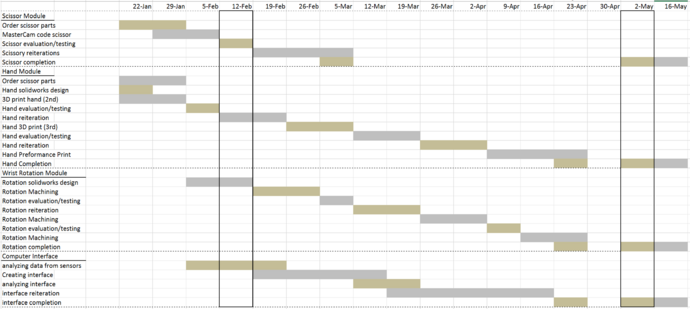
| schedule as of 4/7/2014 |
|---|
